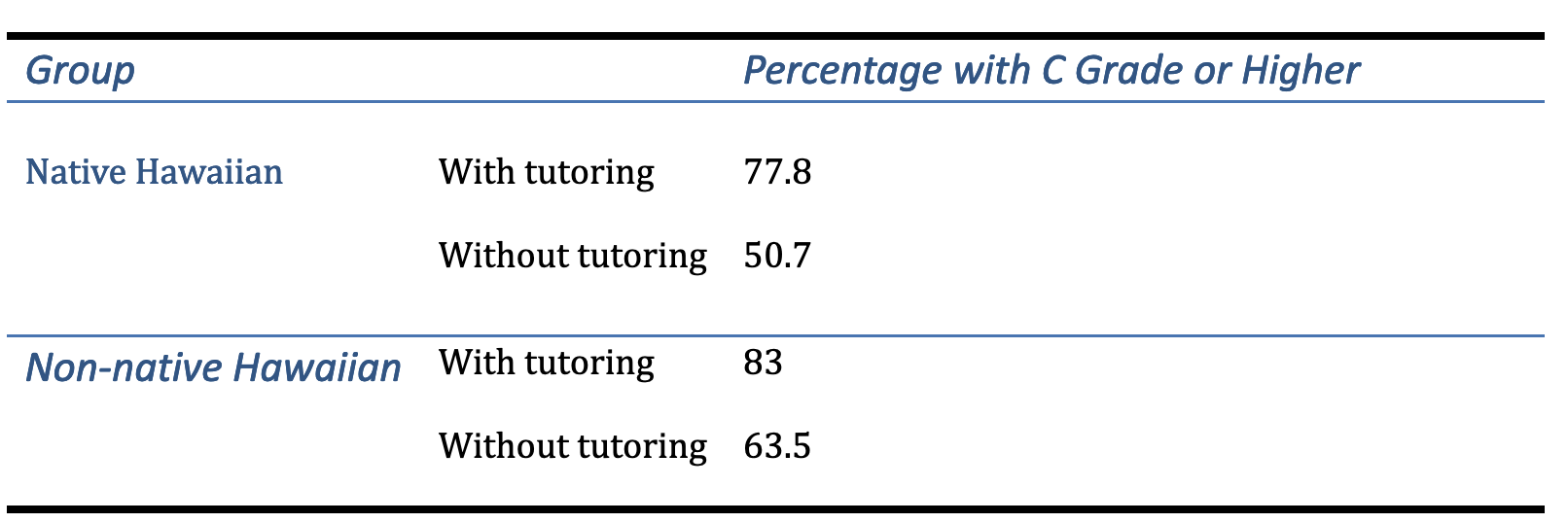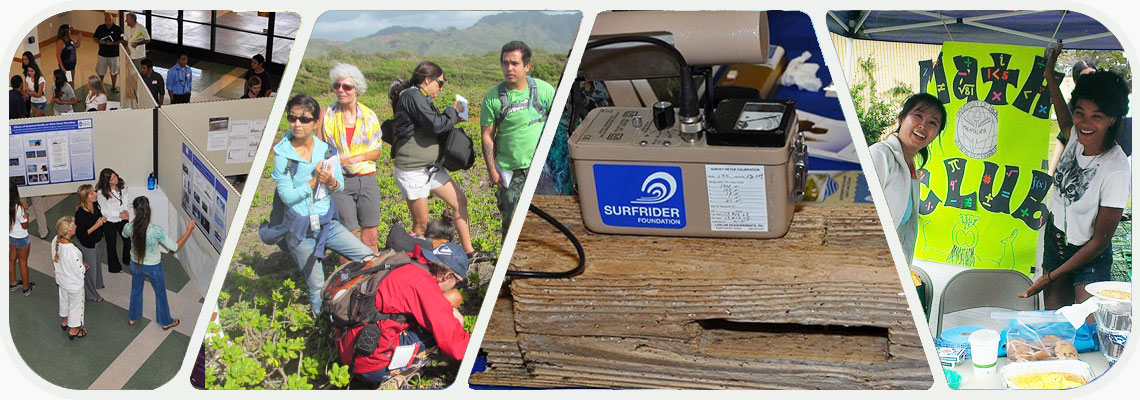A First Year Experience and Support for S.T.E.M.
Grant Budget: $1,045,015
Grant Period: 2012-2014
Grant Type: Part F
This grant created student support and culturally based learning environments that have been extended and expanded during subsequent grants.
Spanning two years, “Building from Our Past” covered two main objectives:
- Enhance and improve recruitment, persistence, and academic success of native Hawaiian students, and
- Support student recruitment, success, support, and transition in STEM (Science, Technology, Engineering, and Math) disciplines.
To strengthen Kaua‘i CC’s capacity to serve native Hawaiian students, this grant established and implemented the following activities:
- The Kipaipai First Year Experience (FYE) Program,
- The Second year transfer (SYE) readiness and explorations program,
- FYE and STEM peer mentoring,
- Alumni peer mentoring,
- STEM embedded tutoring,
- STEM internships, and
- STEM outreach to K-12 schools.
Meeting the intent of the Title III legislation was also accomplished by training faculty to incorporate indigenous values and ways of learning into STEM courses. Studies have shown that community-based, hands-on, group learning involving traditional knowledge is important for native Hawaiian students in particular.
This grant provided faculty with several professional development opportunities focused on understanding and incorporating indigenous values and pedagogy into the curriculum. Classes that were improved as a result include:
- Math
- Astronomy
- Chemistry
- Physics
- Plant Biology
- Sustainability
- Zoology
New courses with indigenous pedagogy were offered, including but not limited to:
- Astronomy developed by Michael Hannawald, offered in Summer/Fall 2015, held field trips and campus events.
- Plant Biology and Tropical Agriculture, taught by Sharad Marahatta, offered laboratory and field studies that included interactions with cultural practitioners.
- Sustainability Science, taught by Laura Williams, engaged students with hands-on place-based projects at a native Hawaiian taro farm and ecological restoration site.
In addition, the grant incorporated cultural practitioners, travel to the other island campuses on and promoted cultural perspectives in STEM.
The programs and initiatives established in this grant were continued in the next part F grant “Crossing Cultures” which developed new and more in-depth indigenous programs in engineering, Hawaiian studies, Early College, and STEM outreach.
The Kipaipai Program was established at Kaua`i CC in 2013 to provide mentoring and staff support for first time college students. Since 2013, this Program has evolved and improved. Please see the current Kipaipai webpage for more information.
Requirements for participating in the FYE program:
- FYE handbook
- Attend one of the New Student Orientation sessions currently offered
- Sign a contract for success
- Enroll in IS103
- Complete the FAFSA annually
- Mid-Term Evaluation
- FYE learning communities
- Attend at least one success workshop each semester
- Maintain Satisfactory Academic Progress
Benefits of participating in the FYE program:
- A scholarship for each semester the student meets requirements. Up to 3 semesters (fall, spring, 2nd fall)
- Peer Mentor support. In the 2nd year, students may be paired with a mentor enrolled at a 4 year institution
- Access to a FYE (or Native Hawaiian) support center
Components:
- First Year Experience Handbook – for all new students providing information on how to register, tutorials on using MyUH portal for various functions, support services and resources available, and college vocabulary definitions.
- New Student Orientation – held in August prior to the start of the semester.
- Contract for Success – agreement to attend classes, stay in contact with FYE staff, meet with peer mentors, seek tutoring support, meet with an academic counselor at least once a semester, and meet all other requirements of the FYE program.
- Maintain Satisfactory Academic Progress – same standards as the Financial Aid Office. 2.0 cumulative GPA and 67% completion rate.
- Complete FAFSA annually – the program offered FAFSA assistance workshops.
- Mid-Term Evaluations – meet with FYE coordinator mid-way through the semester to evaluate the students’ standing in their classes, strategies for improving standing over the rest of the semester, and determine whether they should drop any courses to protect their GPA.
- FYE Learning Communities–Assign students block schedules (morning, afternoon, evening) as a prescribed set of courses/sections (English, Math, IS103, etc.) based on COMPASS scores for the first semester.
- Success Workshops – A series of weekly success workshops offered each semester. and open to the entire campus.
- IS 103 – Require students in program to enroll in IS 103 in fall 2013. Students testing into 2 or more remedial already required to. Intro to college courses are known to be beneficial for new students.
Student Benefits:
- Scholarship
- All students who joined the program will automatically receive the scholarship via the Hawaiian Second Century Scholarship fund, at the beginning of fall 2013.
- If they meet the requirements of the program at end of fall 2013 and re-enroll for spring 2013, they receive the scholarship for that semester.
- Again, if they meet the requirements during the spring 2013 semester and re-enroll in fall 2014, they can receive the scholarship again for the fall 2014 semester only.
- In 2012-13 $27,000 was awarded.
- $41,000 in UH Merit scholarships were awarded in 2012-13
- Access to Peer Mentors – The peer mentors received training on leadership, campus resources, and team building. They attended and assisted with all the NSO sessions. 4 sections of IS 103. The rest of the time, peer mentors held “office” hours to be available to students.
- FYE (or Native Hawaiian) Support Center – Because one of the goals of the Title III grant was to create a “sense of identity” for our Native Hawaiian students, a new center was created to give students a place where they can feel they belong, talk story, receive academic counseling, study together, talk to peer mentors, receive tutoring, and seek support.
- The first objective of the Kipaipai Program was to increase retention rates from fall to spring semesters and to “close the gap” between Native Hawaiian and Non- Hawaiians. The target for cohort one was an 80% retention rate for both groups.
The baseline persistence rate from fall 2012 to spring 2013 was 75% for the general first-time classified population and 71% for Native Hawaiian from this group.
Overall retention rates from fall 2013 to spring 2014 for students in the new Kipaipai Program was 78.8%. While below the target of 80%, was 15% higher than the comparison group of first-year students who were not part of the Kipaipai Program.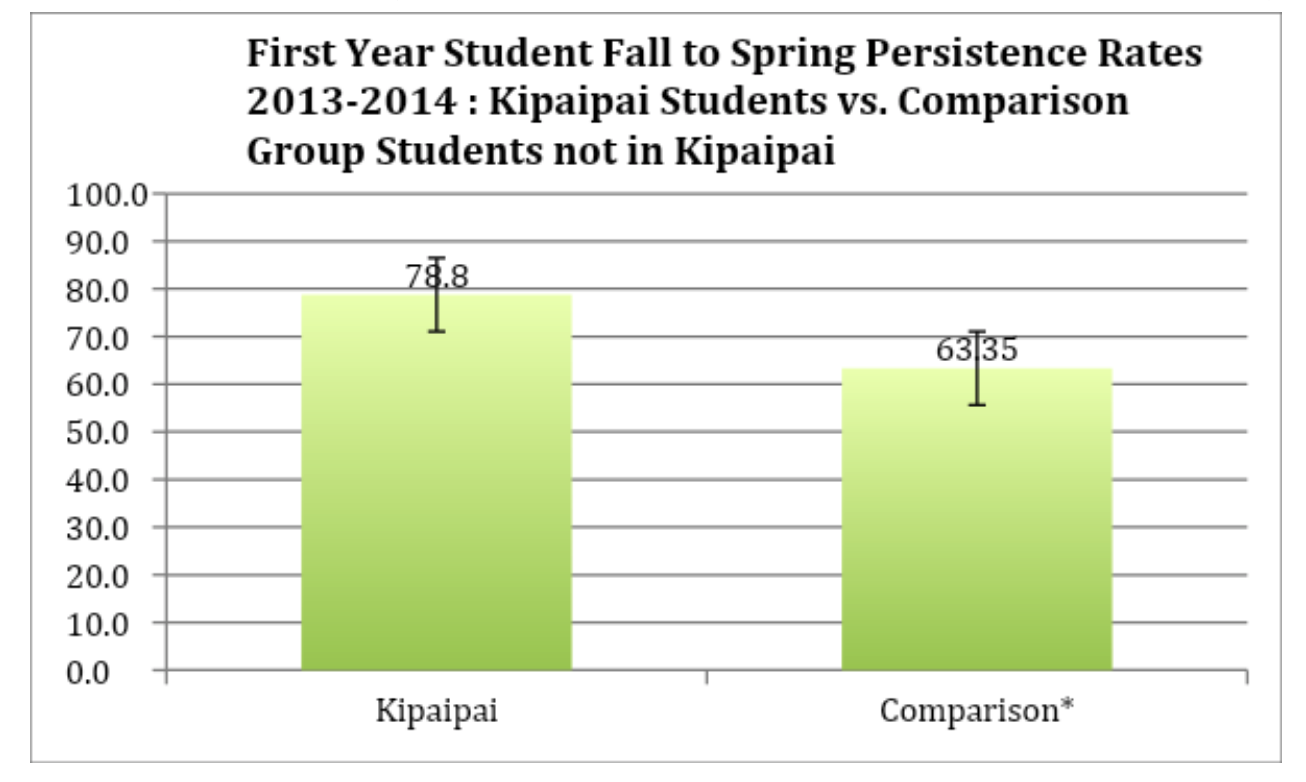
The Kipaipai program also made progress to narrow the success gap between non-Hawaiians and Native Hawaiian fall to spring retention as well. Native Hawaiian students in Kipaipai had higher fall-to-spring retention than non-Hawaiians in the Program.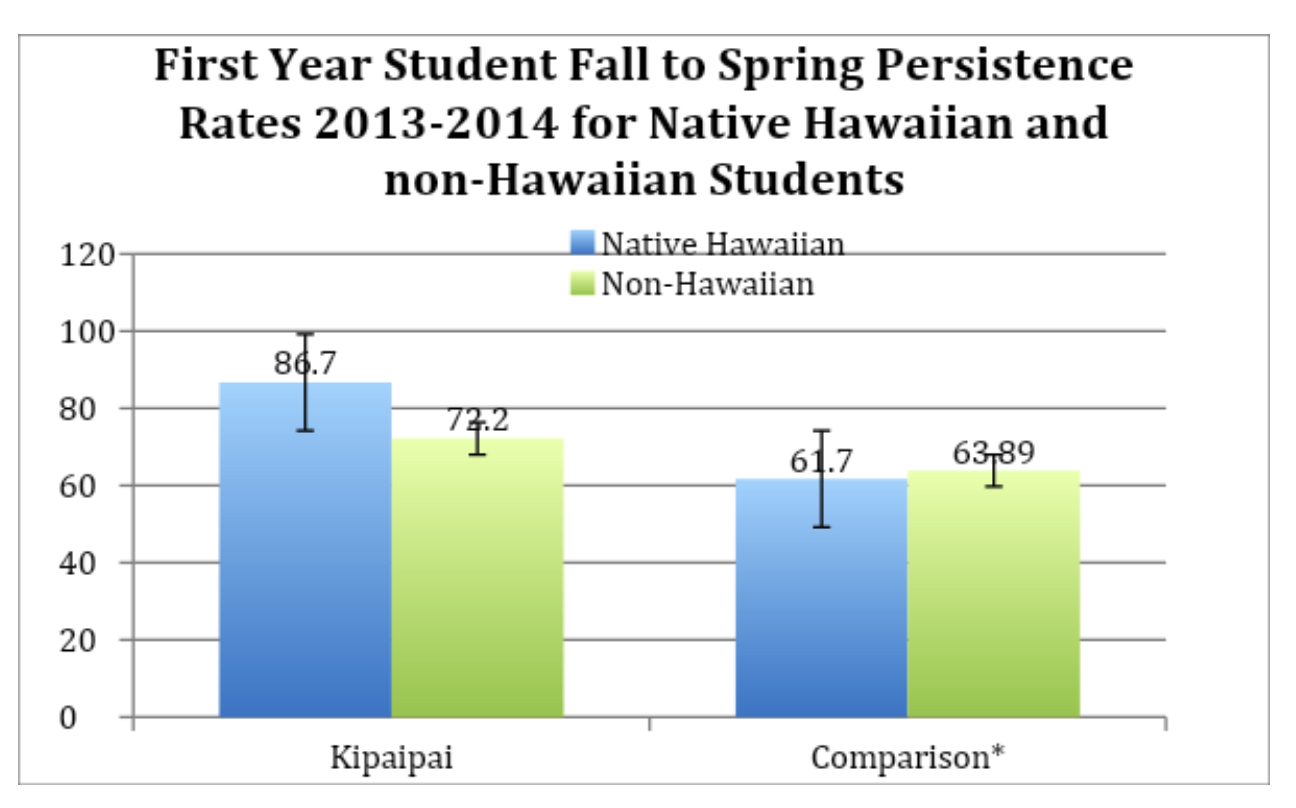
- The second objective of the Kipaipai Program was to increase the year one to year two retention rate and to “close the gap” with non-Hawaiian students. The base persistence rate from fall 2011 to fall 2012 for all students was 55%, (53% for Native Hawaiians). The goal for cohort one was a fall to fall persistence rate of 58% for both groups.
The overall year one to year two retention rate for Kipaipai was 54.6%. Again, though we did not quite meet our goal, the persistence rate was 12% higher than that of the comparison group of first-year students who had not joined Kipaipai.
Though Kipaipai succeeded at increasing the fall-to-fall persistence rate, it did not completely “close the gap” between Hawaiian and non-Hawaiians returning for the second year of college. However, the gap was 13% smaller for students in the Kipaipai program, than for the comparison group. The Kipaipai Program’s successful establishment continued and expanded after this grant ended.
- The first objective of the Kipaipai Program was to increase retention rates from fall to spring semesters and to “close the gap” between Native Hawaiian and Non- Hawaiians. The target for cohort one was an 80% retention rate for both groups.
Peer Mentors
A key component of FYE, as well as STEM degree enhancements, was the implementation of new FYE and STEM peer mentoring. 10 FYE and 2-3 STEM peer mentors supported students through nearly 2,300 hours in and out of the classroom. Peer mentors located themselves inside and outside classrooms, in the cafeteria, or in the library.
Alumni Peer Mentors
Nine alumni mentors within the UH system engaged with over 50 second year students to support them during their transition to UH Mānoa. The establishment of alumni peer mentors and campus travel marked the beginning of the Second Year Experience Program. Activities of this program over two years of this grant included, pairing Kauai CCC students with alumni peer mentors, alumni peer mentor panel discussion events at Kauai CC, campus workshops on transfer topics (funding, housing, life on other islands), and campus tours on O'ahu and Hawai'i Island with alumni peer mentors.
Embedded STEM Tutors
Through Title III, Kauai CC initiated an embedded tutor program for science and math courses. Initiated in the spring of 2013, peer tutors were located in classes to increase academic support for native Hawaiian students by making tutoring more accessible and approachable. The demand for embedded STEM tutors was higher than anticipated, with an average of 15 tutors in 14 different STEM classes. The presence of tutors in classrooms also resulted in higher use of the Learning Resource Center which houses the Tutoring Center (now called the Academic Support Center). Kauai CC also placed an embedded tutor in one Hawaiian Language class to further assist with outreach and connecting to the native Hawaiian students and the places they congregate the most.
Because the costs of implementing these programs are significant, Title III funding was instrumental in Kaua‘i CC’s ability to provide embedded tutors as follows from 2013-2014:
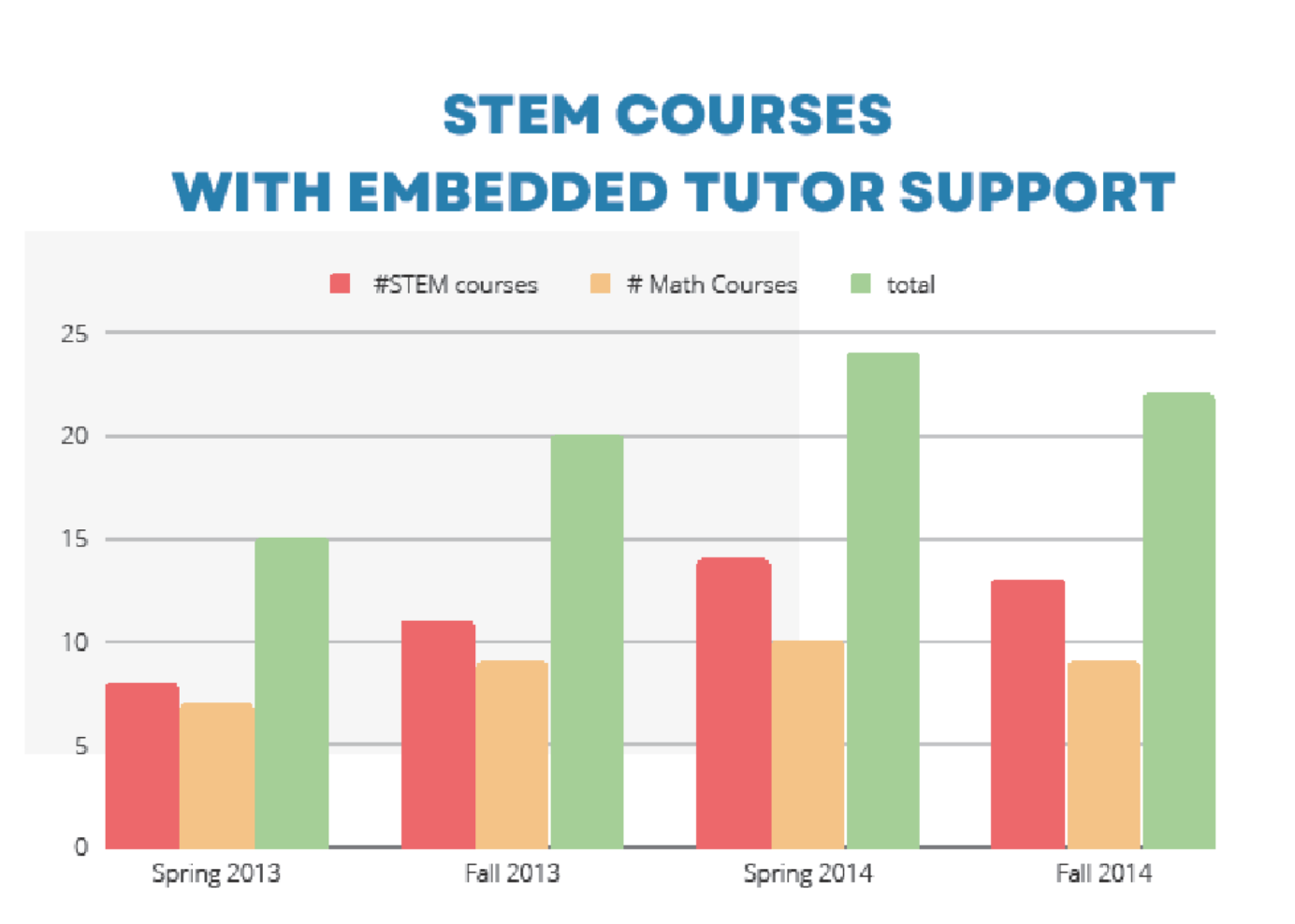
During this grant, tutoring had a positive impact on students who received support within five gatekeeper courses (Math 22, Math 24, English 21, English 22, and English 100) during the Fall 2009 semester.
Tutoring also supported improved Fall to Spring persistence as evidenced by the following:
- A 100% persistence among Native Hawaiian students who used tutoring. compared to those who did not receive tutoring (69.9%
- Almost 90% persistence among all students who used tutoring compared to all students who did not receive any tutoring (77.4%).
The table below provides a snapshot of student Achievement of a C grade or higher 2013-2014 with or without embedded tutoring.
STEM Internship Program
This grant established an internship program through which 2-yr. STEM students were mentored by faculty and community mentors to complete project-based learning. Over two years, 20 students completed STEM internships, and a Science and Technology Ho’ike was created for them to showcase the results of their projects with the community.
This grant also accomplished two STEM field experiences for students per semester. As part of Ethnobotany, students were required to participate in field studies in Koke’e as well as at the National Tropical Botanical Garden (NTBG)
Outreach
Kauai CC initiated weekly visits to senior high school classes (reaching over 520 seniors, completed numerous campus visits at Hawaiian charter schools, and hired a webmaster to create engaging and informative web pages for 13 academic departments and degrees and 20 students support sites (e.g. STEM and new student orientation). The Webmaster created three online videos about student experiences (including one for STEM), and over 150 still photos of students and faculty, available for use in all marketing and outreach materials.
Increase the number of native Hawaiian students in STEM programs to reflect the proportional native Hawaiian student enrollment at the college.
In 2013-2014 Native Hawaiians comprised ~31% of our student population. As of fall 2014, 17 new students have declared STEM ASNS majors. Of these one student is a native Hawaiian. Subsequent grants continued efforts in this area.
